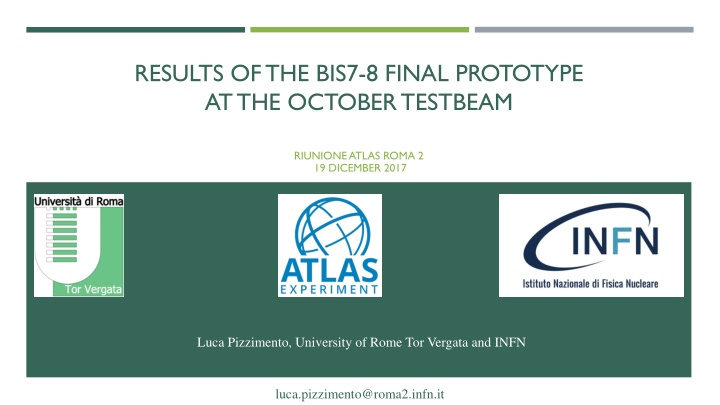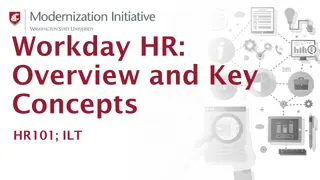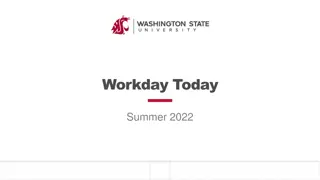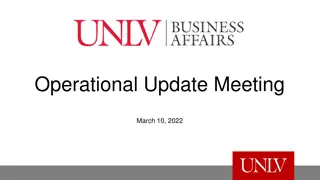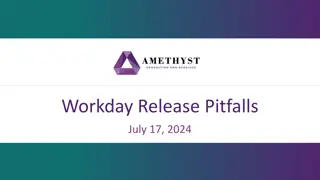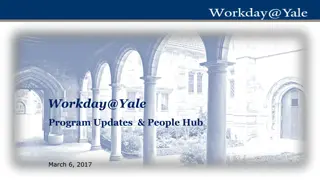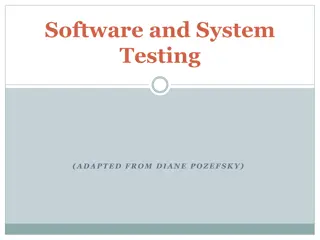Workday@YaleISR Testing Questions
In this testing session, stakeholders review the testing approaches for integrations and the People Hub, syncing environments, system owner readiness, and discuss various scenarios and roles for defect management. The ISR test roles and responsibilities are outlined, emphasizing the importance of coordination and communication among different parties involved in the testing process.
Download Presentation

Please find below an Image/Link to download the presentation.
The content on the website is provided AS IS for your information and personal use only. It may not be sold, licensed, or shared on other websites without obtaining consent from the author.If you encounter any issues during the download, it is possible that the publisher has removed the file from their server.
You are allowed to download the files provided on this website for personal or commercial use, subject to the condition that they are used lawfully. All files are the property of their respective owners.
The content on the website is provided AS IS for your information and personal use only. It may not be sold, licensed, or shared on other websites without obtaining consent from the author.
E N D
Presentation Transcript
RESULTS OF THE BIS7-8 FINAL PROTOTYPE ATTHE OCTOBERTESTBEAM RIUNIONE ATLAS ROMA 2 19 DICEMBER 2017 Luca Pizzimento, University of Rome Tor Vergata and INFN luca.pizzimento@roma2.infn.it
SUMMARY October Test beam at the H8 beamline & experimental setup Testbeam results Chambers efficiency AND configuration Triplet efficiency (2 on 3) Beamprofile Beamprofile eta/phi for each chamberStrip panel layout Cluster Size eta/phi for each chamber Time Resolution & time walk correction Triplet efficiency 2 on 3 with different Vthreshold Triplet efficiency 2 on 3 with different Vamplifier Next to come LUCA PIZZIMENTO 2
OCTOBER TESTBEAM AT THE H8 BEAMLINE This Test beam was realized inside the North Area of CERN, precisely at the H8 beamline. The H8 beam is a secondary particle beam that provides hadrons, electrons or muons of energies between 10 and 400 GeV/c, as well as 450 GeV/c (primary) protons and up to 400 GeV/c per charge primary Pb ions. Only the muon beam was used for this test. Measurement realized: a) BIS78 Final prototype overall test The aim of this test was to ensure that the whole prototype was working correctly b) Parameters phase space scans The aim of these scans is to find out all the possible electronics working points and their properties LUCA PIZZIMENTO 3
TEST BEAM AT H8 EXPERIMENTAL SETUP The BIS78 Final Prototype is composed by 3 mono-gap equipped with both the analogic and the digital FE. The gas gap is 1 mm thick and the electrodes are 1.2 mm thick each. The mixture used was 95% TFE, 4.7% I-C4H10, 0.3% SF6. X,Y ReadOut Strips Gas gap Scintillators The trigger system was composed by two scintillators of around 10cm x 10cm. The data acquisition was realized by using a CAEN TDC. The low voltage system was realized in such a way to have the possibilities to regulate each parameter individually, allowing a deep parameters regulation for each FE board. The FE board low voltages studied: 1. Pull Up & Discriminator The stability of the system 2. Threshold & Amplifier The effective threshold applied on the signals Muon beam LUCA PIZZIMENTO 4 Bis78 Module-0
CHAMBERS EFFICIENCY IN AND CONFIGURATION LV parameter Vth = 1.6 V Efficiency Vpu = 0.4 V Chamber Vamp= 1.5 V TOP MID Vdis = 2.5 V BOT Vtras= 3.5 V HV (V)
TRIPLET EFFICIENCY 2 ON 3 LV parameter Vth = 1.6 V Efficiency Vpu = 0.4 V Vamp= 1.5 V Vdis = 2.5 V Vtras= 3.5 V HV (V)
BEAMPROFILE LV parameter Vamp= 1.5 V Vth = 1.6 V Vtras= 3.5 V Vdis = 2.5 V Vpu = 0.4 V HV= 5600 V
BEAMPROFILE ETA/PHI FOR EACH CHAMBER channel channel channel
CLUSTER SIZE ETA/PHI FOR EACH CHAMBER CS CS CS CS CS CS
TIME RESOLUTION Preliminary TOP_eta BOT_eta TOP_phi BOT_phi HV = 5.6 kV Condizioni di calcolo: 1) Tempo del primo segnale dell evento per lato e per camera 2) LA sottrazione avviene solo per quei tempi che capitano sulla stessa strip delle due camere 3) Considerati i soli casi in cui il primo in tempo anche il massimo dell evento TOP_phi MID_phi TOP_eta MID_eta
TIME RESOLUTIONWITH TIME WALK CORRECTION Preliminary TOP_eta BOT_eta TOP_phi BOT_phi HV = 5.6 kV Condizioni di calcolo: 1) Tempo del primo segnale dell evento per lato e per camera 2) LA sottrazione avviene solo per quei tempi che capitano sulla stessa strip delle due camere 3) Considerati i soli casi in cui il primo in tempo anche il massimo dell evento TOP_phi MID_phi TOP_eta MID_eta Correzione di TimeWalk: (T2-T1) vs A1->Fit-> F(A1) (T2-T1)-F(A1) vs A2->Fit-> F(A2) Plot finale -> (T2-T1)-F(A1)-F(A2)
TRIPLET EFFICIENCY 2 ON 3 WITH DIFFERENTVTH Efficiency Vthreshold LV parameter 1.6 Vth = 1.6 V 1.7 1.8 Vpu = 0.4 V Vamp= 1.5 V Vdis = 2.5 V Vtras= 3.5 V HV (V)
TRIPLET EFFICIENCY 2 ON 3 WITH DIFFERENTVAMP Efficiency Vamplifier LV parameter 1.5 Vth = 1.6 V 1.4 1.3 Vpu = 0.4 V 1 1.8 Vamp= 1.5 V Vdis = 2.5 V Vtras= 3.5 V HV (V)
NEXTTO COME Finishing the Phase Space analysis: Efficiency vs HV vs FE Parameters Time Over Threshold Calibration vs HV vs FE Parameters Time Resolution vs HV vs FE Parameters Cluster Size vs HV vs Parameters Deep Crosstalk study
